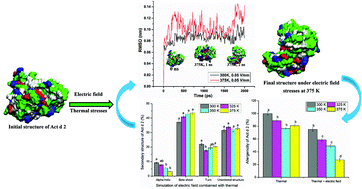Kiwifruit is considered to be the most common plant-based food causing allergic reactions, after peanuts, soybeans, and wheat. These responses are triggered by the proteins in kiwifruit. Modifying the structures of these allergenic proteins (epitopes) through external stresses may decrease their specific binding capacity with antibodies, resulting in a decrease in kiwifruit allergenicity. To provide a visual insight into the structural changes of Act d 2, we treated it with a thermal force and an oscillating electric field using molecular dynamics (MD) simulations. The results showed that Act d 2 is a heat-stable protein, while the electric field combined with thermal stress significantly affected its secondary structure and surface properties, which could result in conformational changes. The results obtained from ELISA tests showed that the combination of the thermal force and electric field significantly reduced the Ig–E binding capacity of Act d 2 by 75.3%, accompanied with obvious losses of alpha-helix and turn structures.

